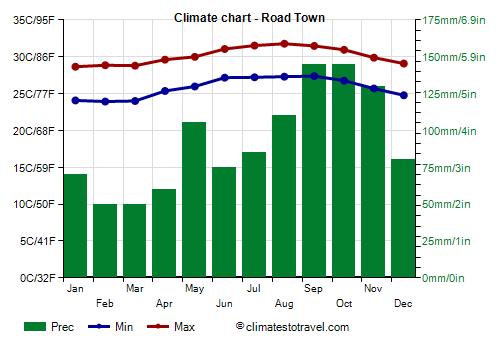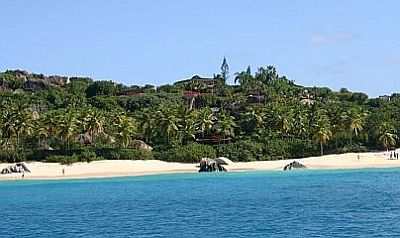Select units of measurement for the temperature and rainfall tables (metric or imperial).
Average weather, temperature, rainfall, sunshine
The climate of the British Virgin Islands is
tropical, hot throughout the year, and also influenced by the trade winds, with a more pleasant period from December to March, when the daily average temperature is around 26 °C (79 °F), and a hotter and sultry period from May to October, when the daily average is around 29 °C (84 °F).
As regards to the
rainfall, there is a relatively dry season from January to April and a rainy season from May to December. The least rainy months are February and March. The annual amount of rainfall is around 1,000/1,200 mm (40/47 in) per year, and generally, it is slightly more abundant on the northern slopes of each island, in particular, those having hills or low mountains in inland areas, such as Tortola and Virgin Gorda.
In April and May, there is an increase in rainfall, although there is often a relative decrease in June and July, followed by a recovery from August to November. Generally, the wettest period is
from September to November.
The British Virgin Islands are located in the Caribbean Sea, at 18 degrees north latitude, in the group of the Lesser Antilles. The main islands are Tortola, Anegada and Virgin Gorda.
The climate in detail
Temperature and rain

In
Road Town, the capital, on the island of Tortola, the average temperature fluctuates between approximately 26.5 °C (79.5 °F) from January to March, to approximately 29.5 °C (85 °F) from July to September.
In Road Town, 1,100 mm (43 in) of rain fall per year, of which more than 100 mm (4 in) from August to November.
Apart from hurricanes, which can bring strong winds and torrential rains but fortunately occur rarely (see below), the weather is normally nice or variable, interrupted by short showers and thunderstorms, more likely and more intense during the rainy season, which means that the
sun shines all year round, in fact there are almost 3,000 hours of sunshine per year.

Sea temperature
The
sea in the British Virgin Islands is warm enough to swim in all year round, being about 26 °C (79 °F) in February and March, and about 29 °C (84 °F) in September and October.
Hurricanes
From June to November, here as in the whole area of the West Indies, there is the danger of
tropical storms and hurricanes, with greater probability from August to October. The archipelago was hit hard by Hurricane Irma in early September 2017.
When to go
The best time to visit the British Virgin Islands runs
from December to April, since it is the least rainy and the least muggy period of the year. Within this period, the months of
January, February and March are the driest and the least hot of all.
In summer, June and July are generally less rainy than August and September, and have also a lower risk of tropical storms and hurricanes, which, as mentioned, are most likely between August and October, that is, when the sea is warmer.
What to pack
From
December to April: bring light clothes, and possibly a scarf for the breeze and a sweatshirt for the evening.
From
May to November: bring lightweight clothing, and possibly a light sweatshirt and a light raincoat for thunderstorms; a sweatshirt and a pashmina for air-conditioned places.
Climate data - British Virgin Islands
| Road Town |
|---|
|
| Jan | Feb | Mar | Apr | May | Jun | Jul | Aug | Sep | Oct | Nov | Dec |
|---|
| Min temp. | 24 | 24 | 24 | 25 | 26 | 27 | 27 | 27 | 27 | 27 | 26 | 25 |
|---|
| Max temp. | 29 | 29 | 29 | 30 | 30 | 31 | 32 | 32 | 31 | 31 | 30 | 29 |
|---|
| Precip. | 70 | 50 | 50 | 60 | 105 | 75 | 85 | 110 | 145 | 145 | 130 | 80 |
|---|
| Prec. days | 11 | 8 | 8 | 9 | 11 | 9 | 10 | 12 | 14 | 14 | 13 | 12 |
|---|
| Humidity | 71% | 70% | 69% | 69% | 72% | 71% | 72% | 73% | 73% | 74% | 75% | 73% |
|---|
| Day length | 11 | 12 | 12 | 13 | 13 | 13 | 13 | 13 | 12 | 12 | 11 | 11 |
|---|
| Sun hours | 8 | 8 | 9 | 9 | 8 | 8 | 9 | 9 | 8 | 8 | 7 | 7 |
|---|
| Sea temp | 26 | 26 | 26 | 27 | 27 | 28 | 28 | 29 | 29 | 29 | 28 | 27 |
|---|